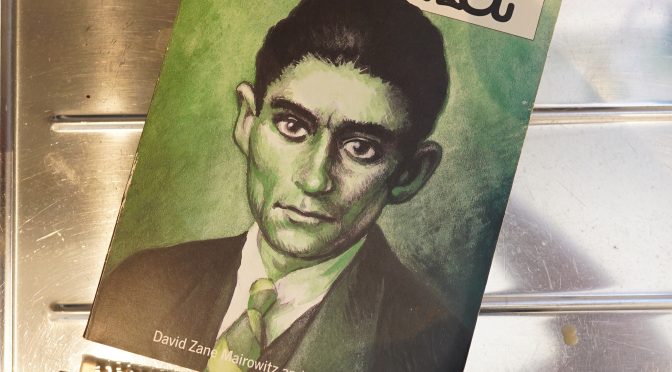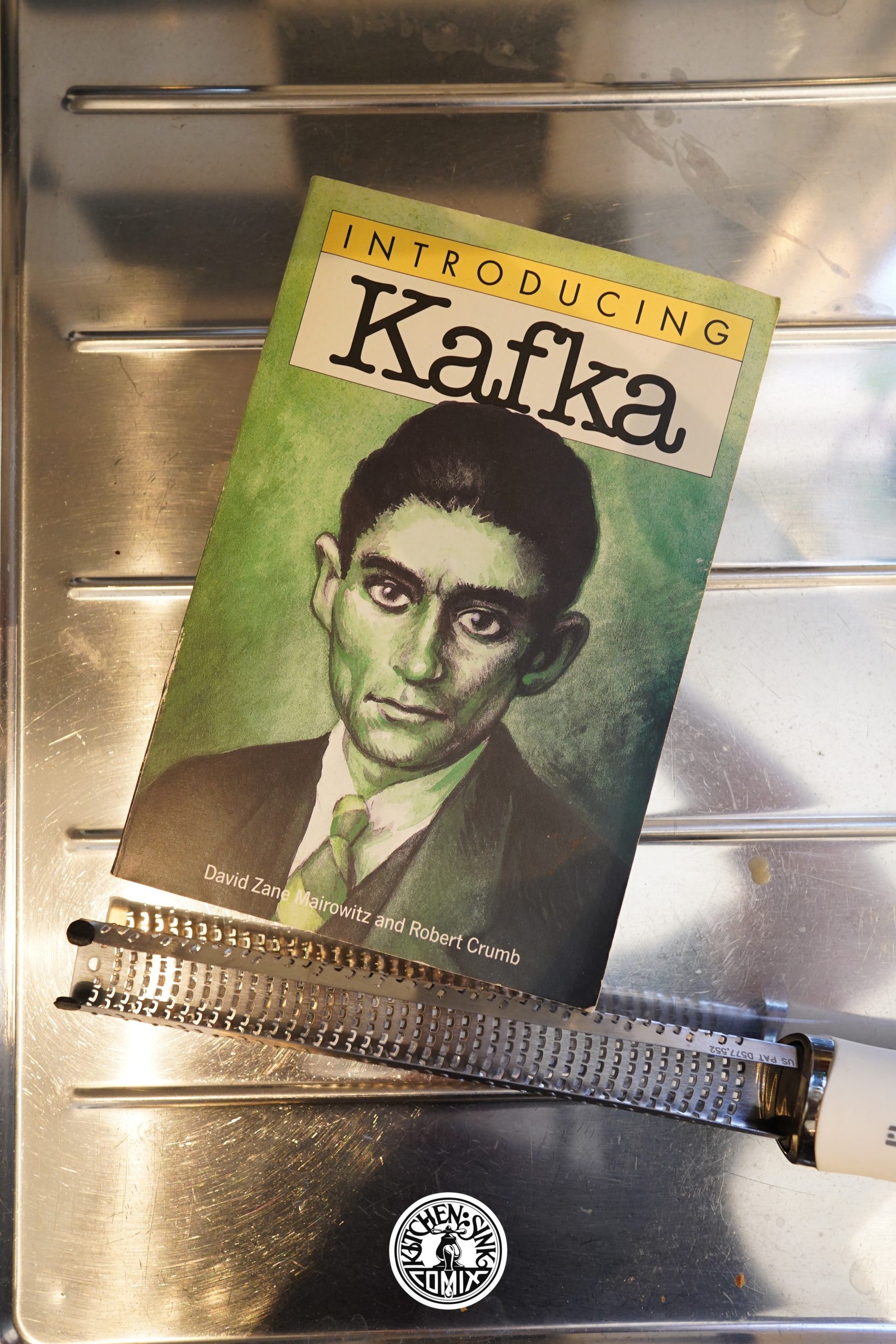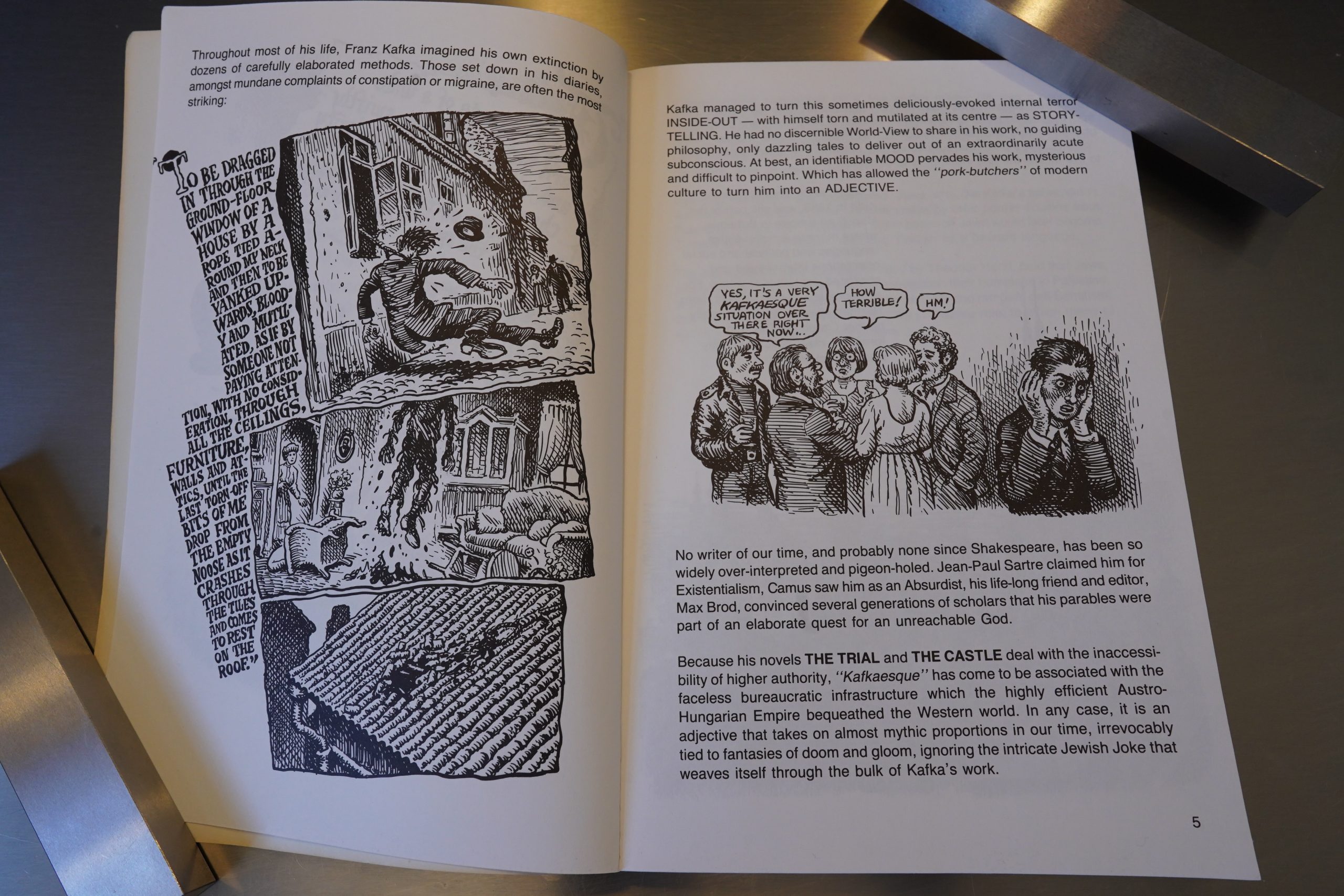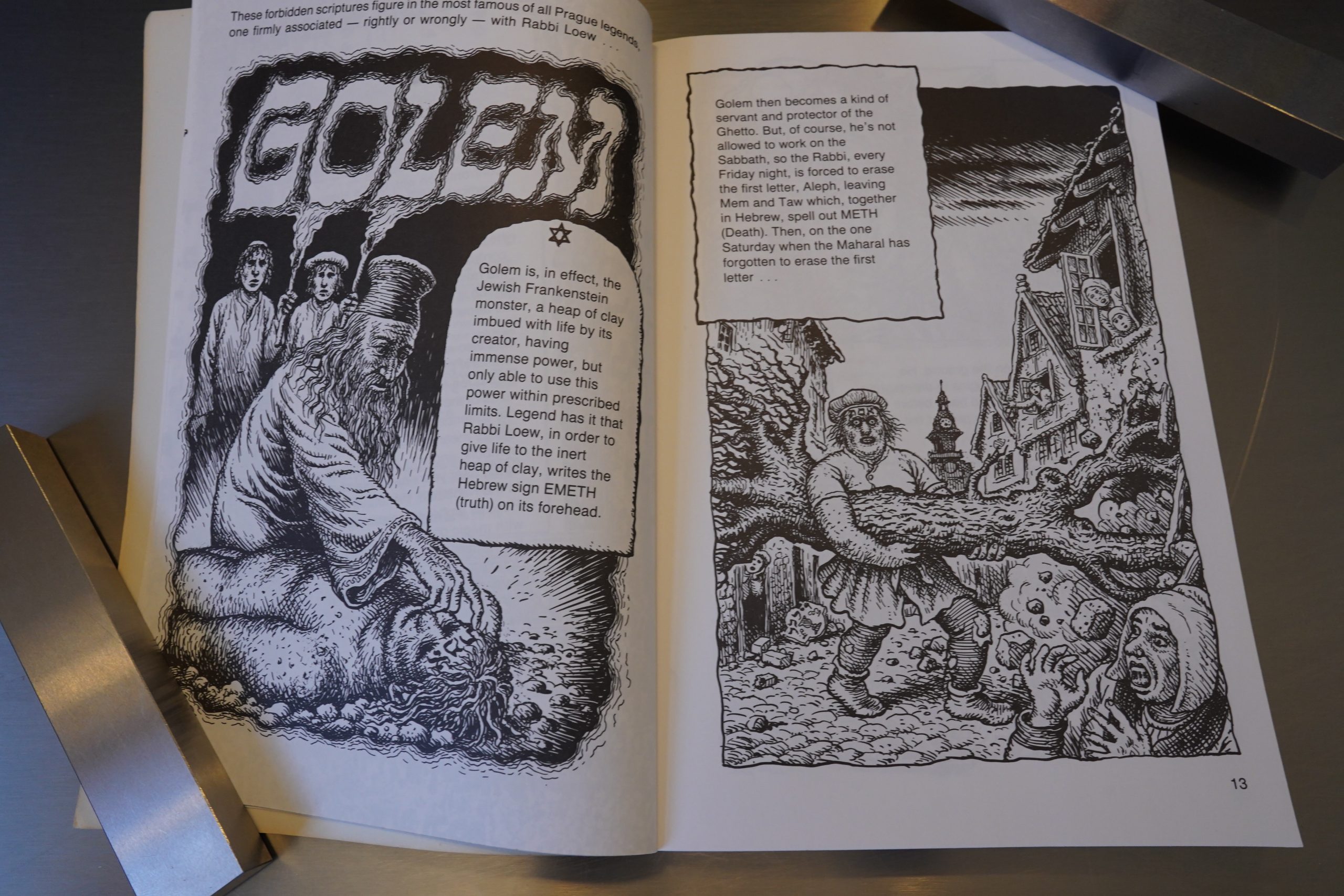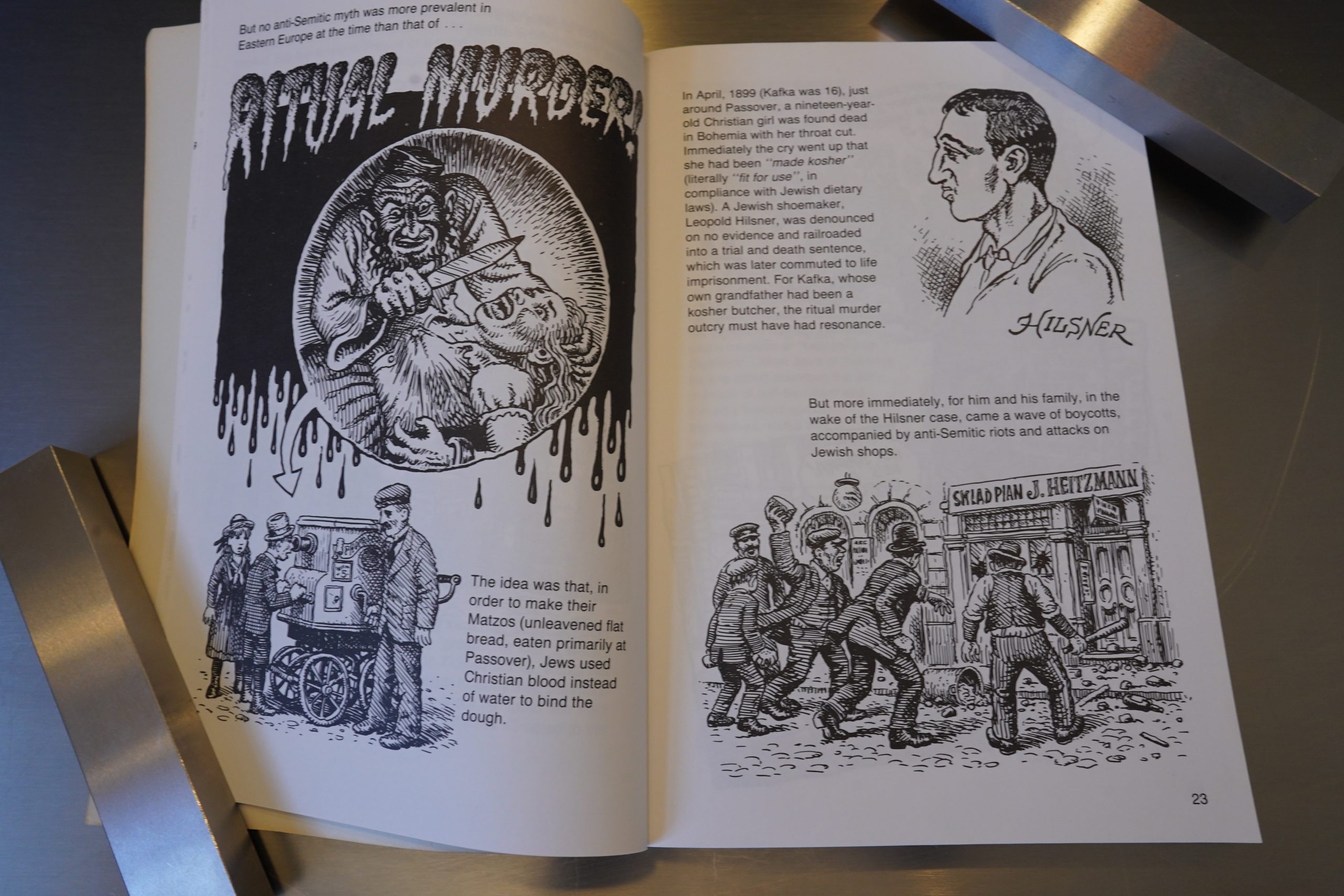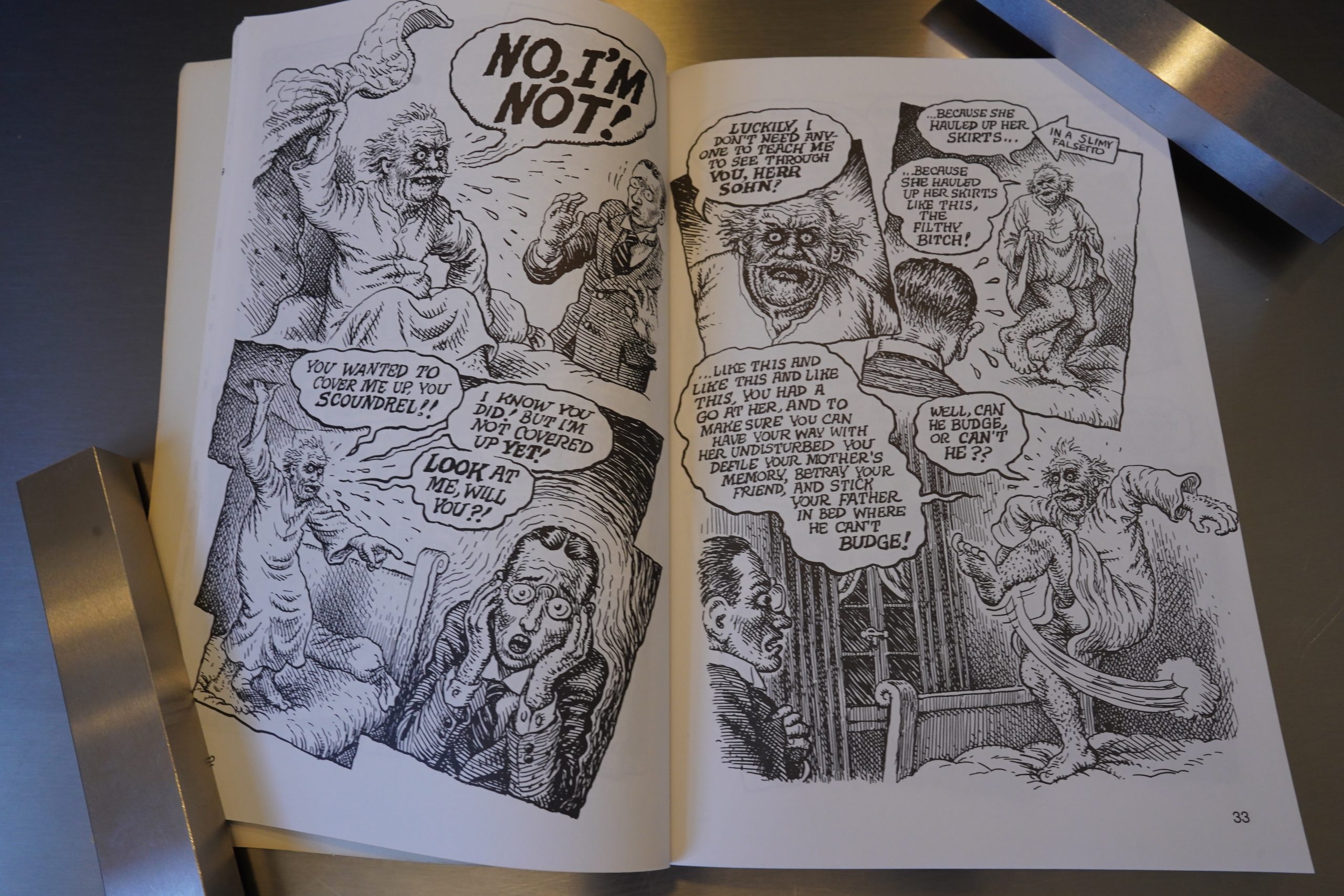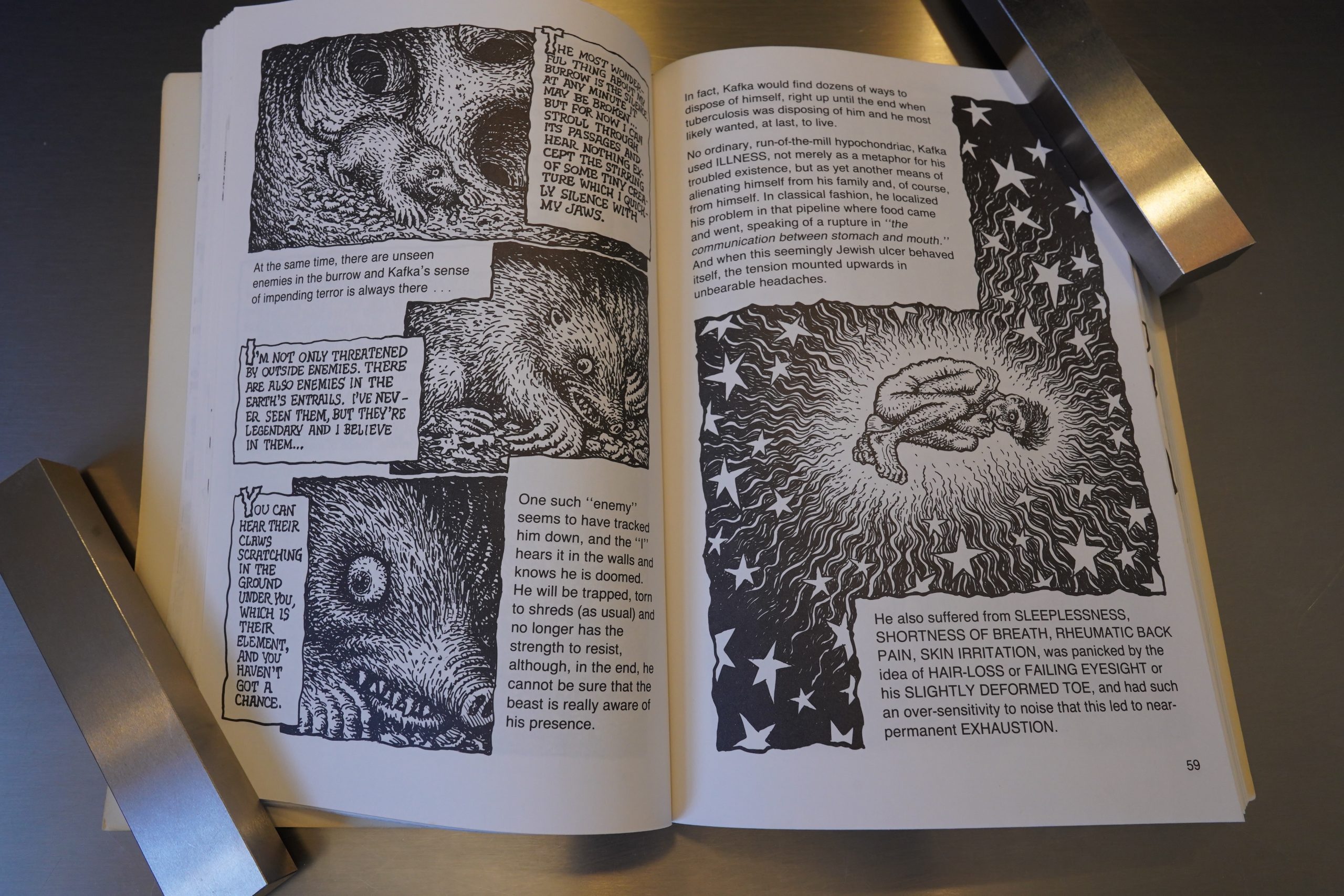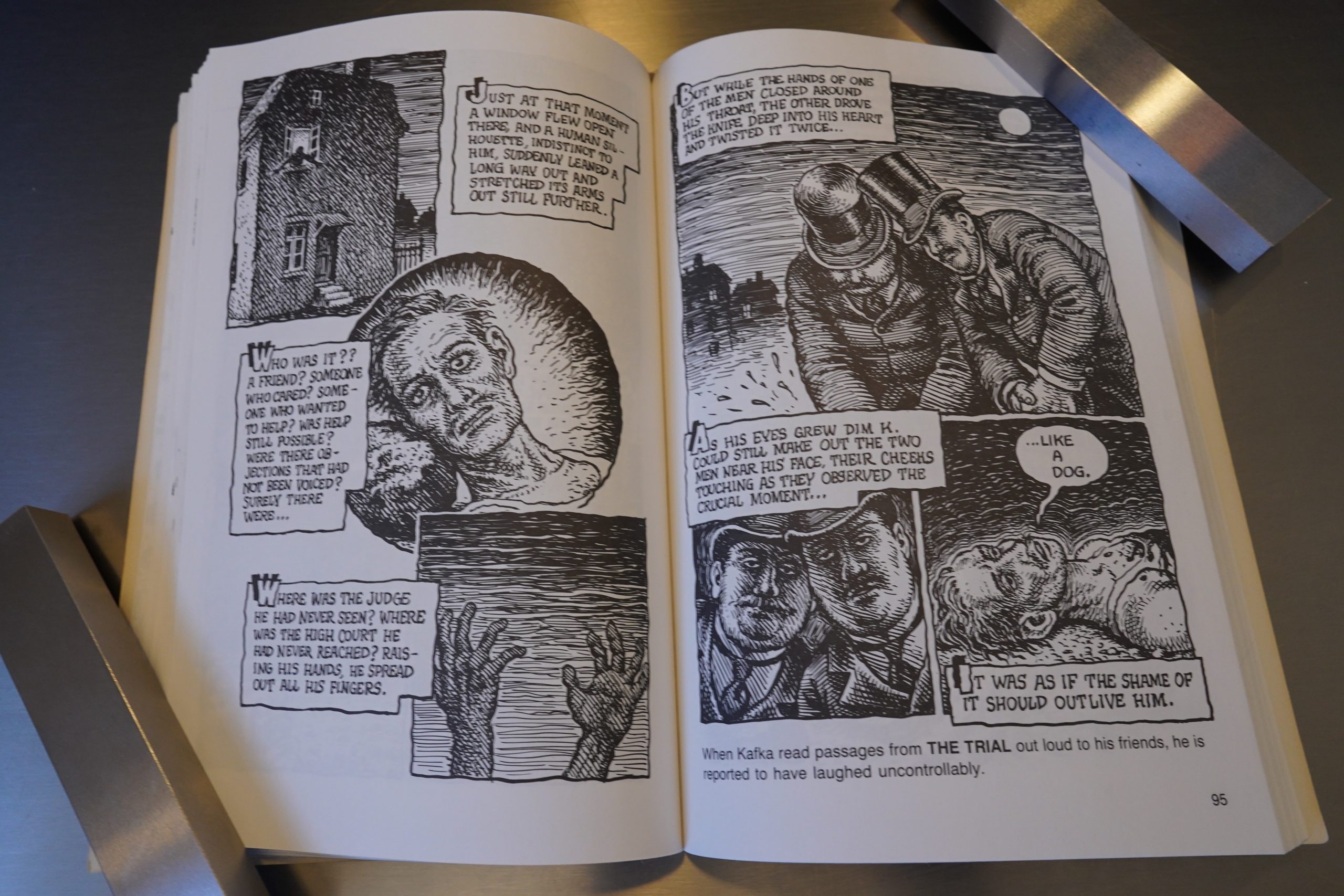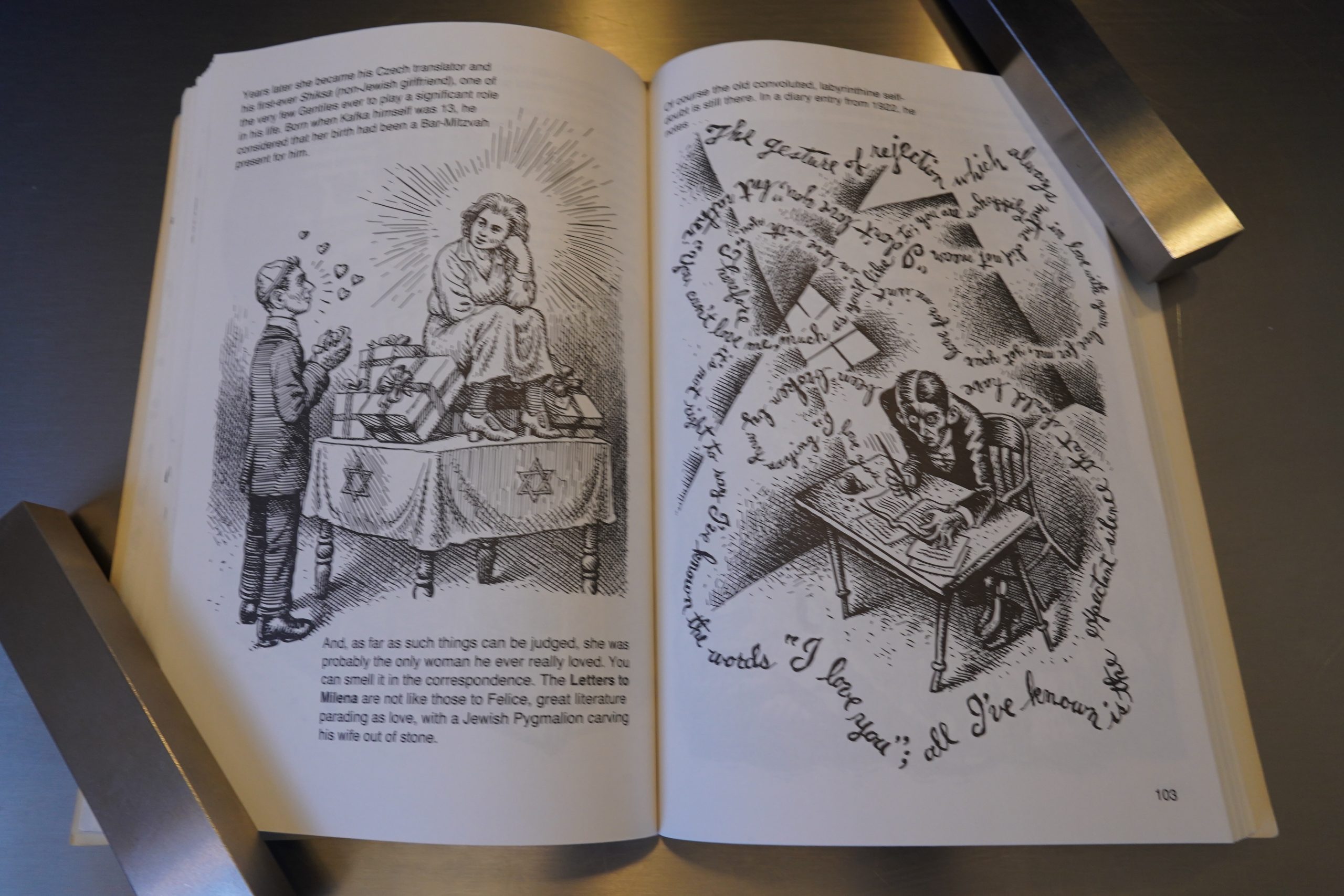Introducing Kafka (1994) by David Zane Mairowitz and Robert Crumb
This was originally published in the UK under the name “Kafka for Beginners”, which is a much better name, I think.
The book is a quite chatty one — it starts off with a polemic against the concept of “kafkaesque”, which is a slightly odd choice. But perhaps it makes sense: What most people know about Kafka is that he is an adjective, and starting with what the reader knows is smart.
This is one of the biggest illustration jobs Crumb has taken on. Crumb was in a creatively odd place at the time (doing many blues biographies and not so many personal books), so perhaps it just gave him breathing space while trying to figure out where to go next. On the other hand, I can totally see that illustrating this book could be something that Crumb had been wanting to do for years.
Mairowitz’s text rolls along quite nicely, but it’s not exactly… scholarly. There’s many, many instances where Mairowitz writes that Kafka “had to have”, or “must have had”, or some other assertion of some conjecture that Mairowitz obviously doesn’t have any reference to back that up.
Most of the book consists of text illustrated by Crumb, but there’s a handful of pure-comics sequences, which is nice, because it provides variety. And besides, if you have Crumb, you’d be insane not to have him do some comics.
Using hand lettering for excerpts from Kafka’s works and typeset for Mairowitz’s text is great.
It’s a knee-slapper alright.
Crumb mostly sticks to his well-known style, but he mixes it up here and there to great effect.
The structure of the book is… er… what structure? We sort of start in the middle, and then zip back and forth and then seem to come to an end, and then the book continues for a couple more dozen pages. It’s very odd, but I think it kinda works? I mean, I was entertained re-reading this.
Crumb is interviewed by Gary Groth in The Comics Journal #180, page 50:
GROTH: Speaking ofsomebody
else’s tragedy, you spent a
year of your life illustrating
Kafka ‘s biography.
CRUMB; Yeah.
GROTH: Which is an unusually
long amount ofrimefor you to
spend on a single project.
CRUMB: I got kind of unknow-
ingly roped into this year’s
work because when I first
agreed todo it I said I could do
an abbreviated bunch of draw-
ings like those other books in
that series. But of course it
turns out I got immersed in all
this detail, so it dragged on
and on and on. But it was an
interesting project. I got to
know Kafka very well. I
hardly ever read him before I
got involved in that. I barely
knew anything about him. But
I got •deeply immersed in
Katka from working On that. I
mean, I ‘m probably one Of the
foremost Kafka experts in the
world now!
GROTH: [laughs] I would assume you would have some sort
of real affinity with him.
CRUMB: It turned out that I did. yeah. The more I worked on
it, the deeper that affinity became until it almost got
spooky after a while; I felt so close to him after a while, it
was almost like I knew him. Have you read much of Kafka?
GROTH: Yeah, I’ve read his short stories.
CRUMB: When you start talking about Kafka, almost every-
body says, “Oh yeah, I had to read him in college.”
GROTH: I read him five or six years ago.
CRUMB: Most people in America have not read much of
Kafka. And his best stuff is the long. books, although
they’re harder to read. But they’re his best work.
GROTH: The novels? Like America and The Trial ?
CRUMB: America… And The Castle I think is the best One.
The Castle is really a masterpiece. But it’ s so claustropho-
bic! But it’s well worth it. Since I was illustrating it, I had
to go back and read certain scenes very closely to make
sure I was accurately portraying this stuff he was describ-
ing. Reading it closely, you get to another level with it, an
incredibly detailed, layered writing that is deceptively
under the surface. You can read it at a certain pace and it’s
written in such a polite. dissident style, that you miss a lot.
You’ rejust reading along, cruising along with it. Butifyou
go back and read it slowly, you start discovering the whole
other layer of stuff that’s going on. It’s really strange that
way, very strange, dream-like. Levels like in dreams.
When I found out that he actually wrote a lot of the time
at night when he was groggy — he was a night writer. He
had a job during the day. and he worked [wrote] at night.
He was probably almost asleep while he was writing. So
he was writing in a very dream-like way. He was such a
compulsive writer that he could… You know how if you
do something enough, you can almost do it in your sleep?
It’s like that with writing. It’s like some musicians are so
good they can almost play music while they’re half asleep.
It’s the same thing.
GROTH: I remember when I read The Meta morphosis
that, like so many people who hadn ‘t yet read it,
I had this vague understanding of what it
was about—a guy turns into a beetle. But
when I read it, all of my expectations went
right out the window and it became SOme•
thing completely other and greater than
I could ever have imagined,
CRUMB: A lot of people assume he’s
going to be like Edgar Allan Poe or
something, a writer of horror stories.
But it’s not quite a horror story. It’s
something much more personal. Psy-
chological, dream-like revelations. Very
Jewish in a way.
Ng Suat Tong writes in The Comics Journal #171, page 57:
WHAT DO CAROLINE LEAF, Peter
Milligan, Brett Ewins, Kenneth Smith, and
Robert Crumb have in common? Well, okay, so
it’s a little obvious. Walk into any library and
you’re bound to find a stack of critical reviews
about Kafka, and Introducing Kafka by David
Zane Mairowitz and Robert Crumb hardly
purports to add anything new to the reams of
literature. This 175-page primer contains
biographical text with illustrations and
adaptations of Kafka’ s short stories and novels.
I’d wager that most Journal readers have
probably bought this book by now, simply on
the basis ofcuriosity. As one ofthe last surviving
“old masters,” Crumb simply demands attention.
But there are potential problems here. Probably
for the first time, Crumb is working with
someone unfamiliar with the art of comics, and
while neuroticism and Jewishness are familiar
hunting grounds, one hardly associates this
kind of material with him.
I suspect that Mairowitz left Crumb very
much to his own devices when it came to the
adaptations in this book. Crumb may even have
been left to illustrate the biographical material
with little or no guidance on Mairowitz’s part,
but I seriously doubt this, since there are certain
sections in the work which do suggest a degree
of cohesiveness — such as this scene where a
group of academics spout words of wisdom
concerning Kafka, including gems like: “The
dream images seem to merge Kafka’s brothel
experiences with his parents’ sexuality and his
mother’s cooking” and “Dietary habits no less
austere than those of orthodox Judaism helped
to cut him off from society.”
There is another section in the book in
which Mairowitz attempts to link the string of
contradictions in Kafka’s life. Here his per-
ceived unhealthiness is contrasted with his abil-
ity to take long walks and to swim during the
winter. In addition, Kafka’s apparent asceti-
cism and unease with sex (“a punishment
for the happiness of being
together”) are thrown into
conflict with his easy
dealings with prosti-
tutes and his somewhat
erotic relationships with
his fiancées. Crumb
(rightly or wrongly)
seems to stress a simple
level of causation in both
these contradictions by
showing a rather tense
Kafta holding the hand
of his irrepressible fa-
theras he leads him away
for a swimming lesson in
the first instance, and then
showing a similarly anxious
Kafka being led away to bed
by his chosen whore. Are we
experiences with prosti- a •
tutes and his father lie at
the root of his feelings
of inadequacy and self-
doubt?[…]
Introducing Kafka is part of a series of
books which have dealt skillfully and amus-
ingly with demi-gods like Darw’in, Einstein,
and Freud, and topics like feminism. The work
in question is certainly as well-drawn as any of
the others I’ve read, and Crumb’s style seems
particularly suited to capturing likenesses (as
may be seen from the British cover to the book,
a portrait of Kafka). But is it as inventive as
Michael McGuiness’ Jung for Beginners, for
example? The comparison may be an unfai r one
since McGuiness had decidedly more leeway in
terms of ideas covered, using etchings and
collage to enhance the text while making know-
ingjibes at Jung’s life and relationships. Some-
how there seems to be little mileage to be gai ned
from making fun of the rather tragic-comic life
of Franz Kafka. Others
would disagree.
On the other hand,
Crumb’s drawings do
give a greater sense of
time and place. He
draws on photos, repro-
ducing and altering
them to suit his pur-
poses and that of
Mairowitz’s text. The
panel layouts and siz-
ing and overall page
design are not to be
dismissed lightly, and
one need only flip
through this book to find
numerous exquisite
borderless drawings.
On a purely superficial
basis, this is probably
one of Crumb’s most
beautiful books, and
that is hardly a word
one normally associates with Crumb’s comic
work (his portfolios being very studious). Hu-
morous, gritty, and confrontational, maybe, but
beautiful?
Ifthis review seems in any way negative, let
me add hastily that I enjoyed reading this little
book. You’ll be hard pressed to find a better
illustrated text On Kafka, and only rarely will
you find Crumb showing as much care with
eachpanel of his work. And let me say one more
thing: this book deserves to be nominated for a
prize. Not for the art, mind you (that hasn’t
changed much over the last few years), but for
the excellent
lettering: ac-
curate and
professional,
demonstrat-
ing an admi-
rable range,
and changing
with each new
letter from
Kafka or his
colleagues.
Dramatically
accentuated at
times,
yet
wholly in har-
mony with the art and, occasionally, adding
considerable beauty to it. If you’re a person
who has read tons of books about Kafka, this
book does afford one or two hours Offun. If you
haven ‘t read any Kafka before (highly unlikely,
I suspect), this book may be slightly expensive,
but does have the potential to encourage further
reading. Which leaves me with but this to say:
buy this book Not only because it’ s by Crumb,
but also because it’s rather good.
The book was reissued by Fantagraphics under the name “Kafka”.
Noah Berlatsky writes in The Comics Journal #286, page 115:
Though they share a superficial interest in
the grotesque and neurotic, R. Crumb and
Kafka are very different artists. Crumb’s
work is confessional, satiric and expansive
— his sexual hang-ups, prejudices and pass-
ingfanciesare splashed about with a visceral,
muddy abandon. Kafka, on the other hand,
is a controlled and understated writer. He
meticulously combines this particular mun-
detail with that incongruous notion
until, in excruciating slow motion, reality
crumbles away in dry, granular flakes.
Having Crumb illustrate Kafka’s biogra-
phy was, therefore, a risky move — and, as it
turns out, a disastrous one. Rather than trp
ing to find a way to adapt his style to Kafka’s
needs, Crumb simply blasts ahead With his
own tropes, turning Kafka’s sly, ambiguous
parables into gag-fests, complete with lov-
ingly rendered gore, big-butted fräuleins,
scrawny protagonists and ironically retro
splash pages.
Not to be left out. writer David Mairow-
itz also does his bone-headed best to turn his
subject into his collaborator. For Mairowitz,
Kafka’s life and art must, like Crumb’s, be
Obviously and everywhere intertwined, and
if the facts don’t fit, well, to hell With them.
Mairowitz is, for example, desperate to link
Kafka’s writing with his Judaism, so he sen-
tentiously retells that hoary folk tale about
the Golem — only to end by admitting that
there’s no evidence that Kafka even knew the
Story.
Heh heh heh; I love it.
Most irritating, though, is Mairowitz’s
knee-jerk tendency to treat Kafka’s art as a
confessional expression Of neurotic symp-
toms, rather than as conscious craft. For
example, Mairowitz notes that Kalka did
not want an insect pictured on the cover of
“Metamorphosis.” the famous novella in
which a man turns into a bug. Mairowitz
explains this reticence by descending into
inane psychobabble, speculating that re-
jecting the picture was a way for Kafka to
mentally “contain the horror of the trans-
formation” or that it was necessary because
“the line between [Kafka’s) feelings about
his body in human form and its ‘insecthood’
was not all that clear.” In the first place, what
rot And, in the second, couldn’t we at least
consider the possibility that one of the most
careful writers in the history of the world
made his aesthetic decisions for, y’know,
aesthe tic reasons?
Don’t get me wrong: I’m Sure that the
links between Kafka’s Judaism, his psychol-
ogy and his art, have been analyzed in many
insightful volumes. This just isn’t one of
them. If you can’t get enough of Crumb be-
ing Crumb, then by all means, pick this up.
But ifyou want to know about Kafka’s life
well, I’d try Wikipedia first.
That’s a brilliant review.
This is the two hundred and thirty-third post in the Entire Kitchen Sink blog series.
